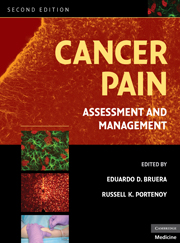Book contents
- Frontmatter
- Contents
- Contributors
- Preface
- SECTION I MECHANISMS AND EPIDEMIOLOGY
- SECTION II EPIDEMIOLOGY AND SYNDROMES
- SECTION III ASSESSMENT
- 5 The assessment of cancer pain: measurement strategy
- 6 Multidimensional assessment: pain and palliative care
- 7 Evaluating pain for children with cancer
- 8 Pain syndromes in cancer survivors
- SECTION IV PHARMACOLOGICAL TREATMENT
- SECTION V OTHER INTERVENTIONAL STRATEGIES
- SECTION VI REHABILITATION AND PSYCHOLOGICAL INTERVENTIONS
- SECTION VII THE ROLE OF ANTINEOPLASTIC THERAPIES IN PAIN CONTROL
- SECTION VIII PAIN IN SPECIAL POPULATIONS
- SECTION IX DIFFICULT PAIN PROBLEMS
- SECTION X SYSTEMS OF CARE
- Index
- Plate section
- References
6 - Multidimensional assessment: pain and palliative care
from SECTION III - ASSESSMENT
Published online by Cambridge University Press: 06 July 2010
- Frontmatter
- Contents
- Contributors
- Preface
- SECTION I MECHANISMS AND EPIDEMIOLOGY
- SECTION II EPIDEMIOLOGY AND SYNDROMES
- SECTION III ASSESSMENT
- 5 The assessment of cancer pain: measurement strategy
- 6 Multidimensional assessment: pain and palliative care
- 7 Evaluating pain for children with cancer
- 8 Pain syndromes in cancer survivors
- SECTION IV PHARMACOLOGICAL TREATMENT
- SECTION V OTHER INTERVENTIONAL STRATEGIES
- SECTION VI REHABILITATION AND PSYCHOLOGICAL INTERVENTIONS
- SECTION VII THE ROLE OF ANTINEOPLASTIC THERAPIES IN PAIN CONTROL
- SECTION VIII PAIN IN SPECIAL POPULATIONS
- SECTION IX DIFFICULT PAIN PROBLEMS
- SECTION X SYSTEMS OF CARE
- Index
- Plate section
- References
Summary
Pain occurs in the majority of patients with advanced cancer and is associated with multiple other symptoms, which in combination are manifested with increasing frequency toward the last days of life. Although the pursuit of World Health Organization (WHO) guidelines can achieve adequate pain relief for 80%–90% of patients with cancer, there is evidence to suggest that this is not achieved in clinical practice. Although there are many potential explanations, the failure to conduct a multidimensional assessment likely plays a significant role in this undertreatment. A multidimensional approach incorporates the assessment of pain in the context of other variables, including other symptoms, therapeutic interventions, and the domains of physical, psychosocial, and spiritual functioning. This approach contrasts with the unidimensional approach, which attributes all aspects of the pain experience (including use of analgesics and psychological distress) to the patient's reported pain intensity.
More than 30 years ago, Melzack and Casey conceptualized pain as being composed of three major dimensions: sensory–discriminative, motivational–affective, and cognitive–evaluative. However, there are relatively few literature references to the multidimensional nature of cancer pain before the publication of a study by Ahles et al. in 1983. This study demonstrated that pain occurring in association with cancer consisted of the following general components: sensory (including characteristics such as site, radiation, intensity, and quality); affective (including mood disturbance and anxiety); cognitive (including the influence of pain on thought processes, and the meaning of pain); and behavioral (including use of analgesic medication, and relationship of pain to activities of daily living).
- Type
- Chapter
- Information
- Cancer PainAssessment and Management, pp. 105 - 129Publisher: Cambridge University PressPrint publication year: 2009



